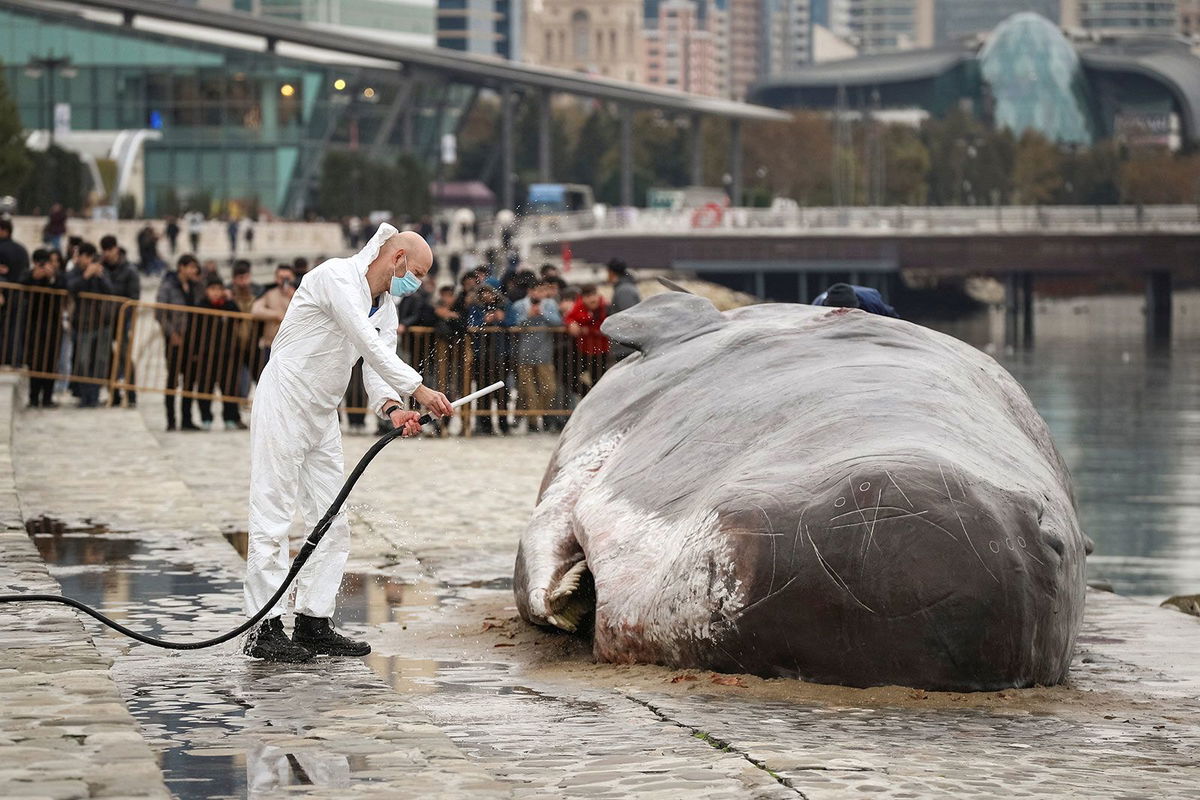Why thousands are gathering around a rancid ‘dead whale’ by the world’s biggest lake

Thousands have gathered to see the beached whale installation
By Laura Paddison, CNN
(CNN) — An enormous, rancid-smelling, 52-foot sperm whale has lain beached on the shoreline of the Caspian Sea, the world’s largest lake, since Monday.
It’s a jarring sight; no sperm whales live in this vast body of water. Many of the people who gathered to see the giant marine mammal on the coast of Azerbaijan’s capital Baku have never seen a whale like it.
This dead whale, however, is not real. It’s a hyper-realistic model made by an organization called Captain Boomer, a Belgian-based collective of actors, sculptors and scientists, who are trying to raise awareness of global ecological destruction, including the human-caused climate crisis.
It was created using molds from real whales and its smell comes from buckets of rotting fish hidden nearby to add to the illusion.
Since it was created a decade ago, the model whale has been touring cities and coasts, from Europe to Australia. “When we think the story is right, we pop up in a city,” said Bart Van Peel of Captain Boomer.
Now, the collective has decided to “beach” the whale on the shores of Baku, as global leaders gather in the city for the UN-backed climate summit COP29, where they will discuss how to tackle the escalating climate crisis.
The aim is to play with fact and fiction, to challenge people’s beliefs and make them think, Van Peel told CNN. This incongruous animal makes “people feel that their bond with nature is disturbed,” he said.
The whale’s journey to Azerbaijan from its home in Belgium was long. Members of Captain Boomer loaded it onto a truck and drove through Europe, Turkey and Georgia, before finally arriving in Baku two weeks later.
The group got approval from Azerbaijani authorities for the installation, with help from a local activist Adnan Hussein who started the FINS initiative, which works to protect marine species. They plan to keep the whale there through the whole of the climate conference.
The installation is accompanied by a kind of street theater, where members of the collective play the roles of scientists trying to establish what happened to the whale. They make up a “tapestry of stories,” Van Peel said. “Like, maybe because of climate change, it changed its migration route.”
As humans continue to heat up the world by burning fossil fuels, whales, like all marine life, are increasingly vulnerable. Warmer ocean temperatures can affect their food and force them to change their migration routes, potentially placing them more at risk from human activities like shipping and fishing.
So far, thousands of people have gathered to stare at the whale since it was installed early Monday morning, Van Peel said. Some have stayed more than an hour and many have had “very emotional reactions,” he said.
For Van Peel the power is in bringing people together around the sperm whale’s anomalous presence. “It’s this gesture of a beast coming from another element and throwing itself at our feet and saying: ‘Look, I can’t anymore.’ There’s an exhaustion. It’s a big question mark. What are you going to do?”
The-CNN-Wire
™ & © 2024 Cable News Network, Inc., a Warner Bros. Discovery Company. All rights reserved.